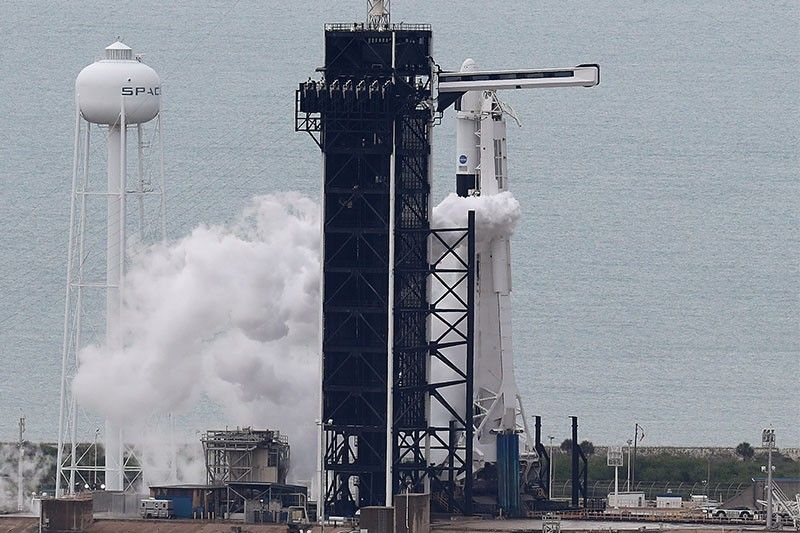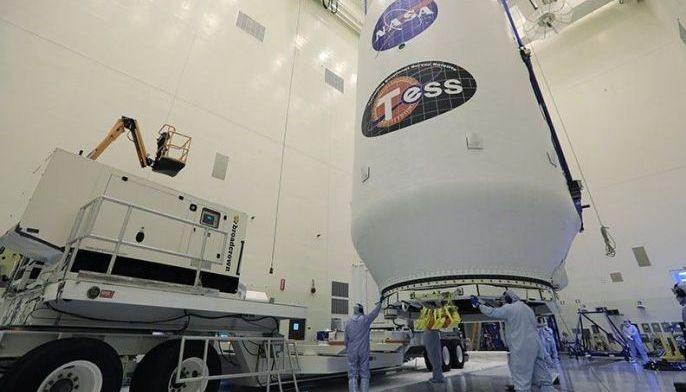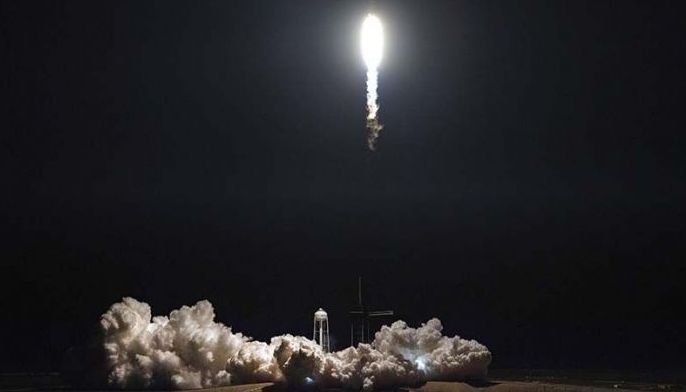SpaceX, NASA delay milestone mission due to bad weather

UNITED STATES — SpaceX's landmark launch to the International Space Station — the first crewed mission to blast off from US soil in almost a decade — was scrubbed Wednesday due to bad weather.
With NASA astronauts Bob Behnken and Doug Hurley strapped into the Crew Dragon capsule, the launch pad platform retracted and rocket fueling underway, SpaceX made the call to abort.
"Unfortunately, we are not going to launch today," launch director Mike Taylor said, with less than 20 minutes to go until takeoff.
Officials cited the threat of lightning, among other factors.
It means a wait of at least a few more days for the first crewed launch on an American rocket since the space shuttle program ended in 2011. They will try again on Saturday.
If successful, the launch will be the first time the feat has been performed by a privately-owned company.
A live video feed showed Behnken and Hurley — in their futuristic white uniforms adorned with the US flag and the logos of NASA and SpaceX — waiting as propellant was unloaded from the reusable Falcon 9 rocket.
The emergency ejection system remained armed until the fuel tanks were emptied, in case of an accidental explosion.
The launch had been scheduled for 4:33 pm (2033 GMT) from the Kennedy Space Center's Launch Pad 39A. Neil Armstrong and his Apollo 11 crewmates lifted off from the same spot on their historic journey to the Moon.
The mission comes despite shutdowns caused by the coronavirus pandemic, with the crew in quarantine for the past two weeks.
President Donald Trump and First Lady Melania Trump had arrived in Florida to watch, but headed back to the White House once the launch was called off.
SpaceX win over Boeing
Founded in 2002, Space Exploration Technologies Corp. has torn up the rules to produce a lower-cost alternative to human spaceflight that has gradually won over skeptics.
By 2012, it had become the first private company to dock a cargo capsule at the ISS, resupplying the station regularly ever since.
Two years later, NASA ordered the next step: to transport its astronauts there by adapting the Dragon capsule.
"SpaceX would not be here without NASA," founder Elon Musk said last year, after a successful dress rehearsal without humans for the trip to the ISS.
The US space agency paid more than $3 billion for SpaceX to design, build, test and operate its reusable capsule for six future space round trips.
The project has experienced delays, explosions, and parachute problems — but even so, SpaceX has beaten aerospace giant Boeing to the punch.
Boeing's NASA entry, the Starliner, is still not ready.
The move by NASA to invest in privately developed spacecraft — a more budget-friendly proposition than spending tens of billions of dollars developing such systems itself, as it had done for decades — was begun under the presidency of George W. Bush for cargo, and then under Barack Obama for human flight.
At the time, there was immense hostility in Congress and NASA to the start-up's claims of what it could achieve.
Ending dependence on Russia
A decade on, it was Trump who was present for the launch.
The Republican is trying to reaffirm American domination of space, militarily but also by ordering a return to the Moon in 2024.
If NASA can entrust "low Earth orbit" space travel to the private sector, it would free up dollars for its more distant missions.
"We envision a future where low Earth orbit is entirely commercialized, where NASA is one customer of many customers," NASA chief Jim Bridenstine said.
Crew Dragon is a capsule like Apollo, but updated for the 21st century. Touch screens have replaced switches. The interior has more subtle lighting.
It looks entirely different from the huge winged space shuttles that carried astronauts into space from US soil from 1981 to 2011.
"We're expecting a smooth ride but we're expecting a loud ride," said Behnken, who, like Hurley, flew in the shuttles twice.
Unlike the shuttles, one of which — the Challenger -—exploded in 1986 after launch, Dragon can eject in an emergency if the Falcon 9 rocket has a problem boosting it into space.
When the mission eventually goes ahead, Crew Dragon will catch up with the space station, and will probably remain docked there until August.
If it fulfills its mission and is certified safe, it will mean the Americans will no longer depend on Russia for access to space: since 2011, the Russian Soyuz rockets were the only space taxis available.
Monitor major developments on space explorations and the status of missions.
NASA reveals a sample collected from the 4.5-billion-year-old asteroid Bennu contains abundant water and carbon, offering more evidence for the theory that life on Earth was seeded from outer space.
The discovery follows a seven-year-round-trip to the distant rock as part of the OSIRIS-REx mission, which dropped off its precious payload in the Utah desert last month for painstaking scientific analysis.
"This is the biggest carbon-rich asteroid sample ever returned to Earth," NASA administrator Bill Nelson says at a press event at the Johnson Space Center in Houston, where the first images of black dust and pebbles were revealed. — AFP
NASA is set to reveal on Wednesday the first images of the largest asteroid sample ever collected in space, something scientists hope will yield clues about the earliest days of our solar system and perhaps the origins of life itself.
The OSIRIS-REx mission collected rock and dust from the asteroid Bennu in 2020, and a capsule containing the precious cargo successfully returned to Earth a little over two weeks ago, landing in the Utah desert.
It is now being painstakingly analyzed in a specialized clean room at NASA's Johnson Space Center in Houston. — AFP
A Spanish company launches the country's first private rocket on Saturday in a step towards bringing Spain into the exclusive club of space-faring nations.
The launch of the small MIURA1 rocket took place at 02:19 am (0019 GMT) from a military base in the southern region of Andalusia, according to the company, PLD Space.
The company hailed the launch as "successful" and said it had achieved all its "technical objectives". — AFP
India's Sun-monitoring spacecraft has crossed a landmark point on its journey to escape "the sphere of Earth's influence", its space agency says, days after the disappointment of its Moon rover failing to awaken.
The Aditya-L1 mission, which started its four-month journey towards the centre of the solar system on September 2, carries instruments to observe the Sun's outermost layers.
"The spacecraft has escaped the sphere of Earth's influence," the Indian Space Research Organisation (ISRO) says in a statement. — AFP
Carbon dioxide detected on Jupiter's moon Europa comes from the vast ocean beneath its icy shell, research using James Webb Space Telescope data, potentially bolstering hopes the hidden water could harbour life.
Scientists are confident there is a huge ocean of saltwater kilometres below Europa's ice-covered surface, making the moon a prime candidate for hosting extra-terrestrial life in our Solar System.
But determining whether this concealed ocean has the right chemical elements to support life has been difficult. — AFP
- Latest

































